Canoes vs Kayaks – What are the differences?
If you are new to paddling and trying to figure out which boat would suit you best, you’re going to be faced with the canoe vs kayak dilemma, this is a common question for people looking to get into this activity. In this article, we’re going to dive in and give you a full breakdown of the differences between the two and the pros and cons of owning either craft.
The Key difference between canoeing and kayaking in terms of paddles, seats, and hulls
Paddle Type


One of the most obvious differences between canoes and kayaks is the type of paddle they use. Canoes typically use a single-bladed paddle that is held in one hand, while kayaks use a double-bladed paddle that is held in both hands. This means that canoeists have to switch sides every few strokes to keep the boat moving straight, while kayakers can paddle on either side without changing hands.
Type of Seat & Seat Position
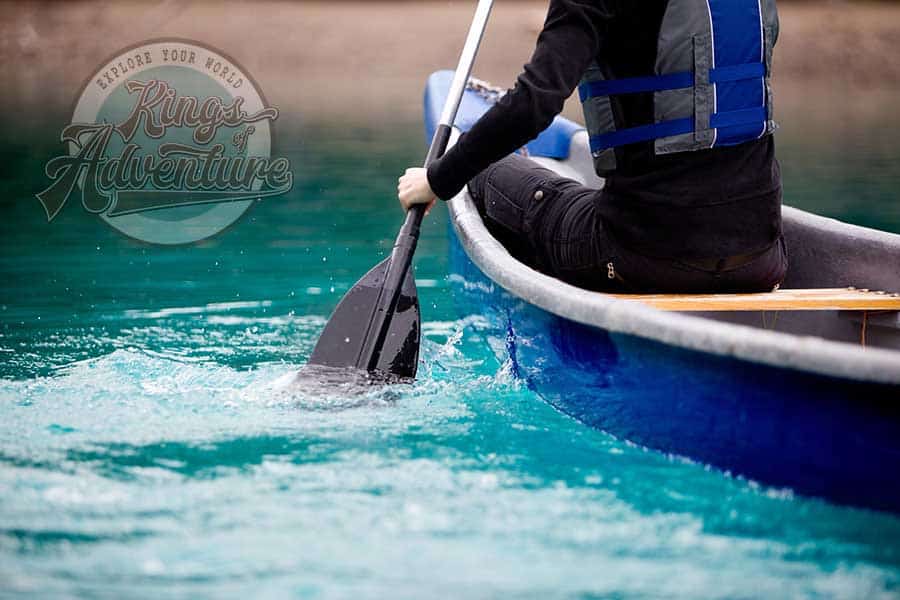
Another difference is the position of the seats. Canoes usually have raised seats that allow the paddlers to sit or kneel, while kayaks have low seats that require the paddlers to sit with their legs stretched out in front of them. This affects the stability and maneuverability of the boats, as well as the comfort and ease of getting in and out.
Hull Shape
The third difference is the shape of the hulls. Canoes tend to have a flat or slightly rounded bottom that makes them more stable on calm water, but less agile on rough water. Kayaks have a more streamlined and tapered hull that makes them faster and more responsive, but also more prone to tipping over. Some kayaks also have a closed cockpit that covers the paddler’s lower body, which provides more protection from water and cold, but also makes it harder to escape in case of a capsize.
These are a few of the main differences between canoeing and kayaking in terms of paddles, seats, and hulls. Of course, there are also variations within each category, such as different types of canoes (e.g. recreational, whitewater, touring) and kayaks (e.g. sea, river, inflatable), that have their own advantages and disadvantages depending on the intended use. We will discuss these later in this article.
The pros and cons of canoes and kayaks for different types of water and activities
Both canoes and kayaks can be used for a variety of water-based activities, such as fishing, camping, exploring, or just relaxing. However, depending on the type of water and the level of challenge you are looking for, one may be more suitable than the other. Here are some of the pros and cons of canoes and kayaks for different types of water and activities:
Calm water
If you are looking for a leisurely paddle on a lake, pond, or slow river, a canoe may be a better choice than a kayak. Canoes are more stable and spacious, which means they can carry more people and gear, as well as offer more comfort and flexibility. You can also enjoy the scenery better from a higher vantage point and view underwater life easier due to less water surface reflection due to your more elevated position. However, canoes are also heavier and slower than kayaks, which means they require more effort and coordination to paddle. They are also more affected by wind and waves, which can make them slightly harder to steer.
Rough water
If you are looking for an adrenaline rush on a fast river, ocean, or surf, a kayak may be a better choice than a canoe. Kayaks are more agile and responsive, which means they can handle rapids, waves, and currents better than canoes. They are also faster and more efficient than canoes, which means they require less energy and time to cover the same distance. However, kayaks are also less stable and more prone to tipping over than canoes, which means they require more skill and confidence to paddle. They are also less spacious and comfortable than canoes, which means they have less room for people and gear.
Other activities
If you are looking for something else besides just paddling, such as fishing, camping, or wildlife watching, both canoes and kayaks have their pros and cons. Canoes are better for fishing because they offer more stability and space for rods, tackle, and fish. They are also better for camping because they can carry more equipment and supplies. However, canoes are harder to transport and launch than kayaks, which means they may limit your access to some places.
Kayaks are better for wildlife watching because they offer more stealth and maneuverability to get closer to animals. They are also better for exploring because they can reach places that canoes cannot, such as narrow creeks or caves. However, kayaks are less comfortable and versatile than canoes, which means they may not suit everyone’s preferences or needs.
Of course, there is no definitive answer to which one is better, as it depends on your personal goals, skills, and preferences.
Canoes v Kayaks – The Details
Let’s Clear any Confusion:
Americans use the term “canoe” to describe a paddlecraft with an open deck and the seats positioned level with, or, just below, the gunwale (aka gunnel); and the term “kayak” to refer to a paddlecraft with a closed deck and a seat that is positioned adjacent to the bilge (the interior bottom of the hull).
Both Canadians and Brits refer to a canoe as a “Canadian canoe” and to a kayak as a “canoe”. However, regardless of the terminology that you use to designate each type of paddlecraft, the advantages and disadvantages of each type of paddlecraft are the same.
The confusion does not stop there because there are several different classes of both canoes and kayaks and each type is specifically designed for a different purpose. So, what are the main differences between canoes and kayaks?
CANOES
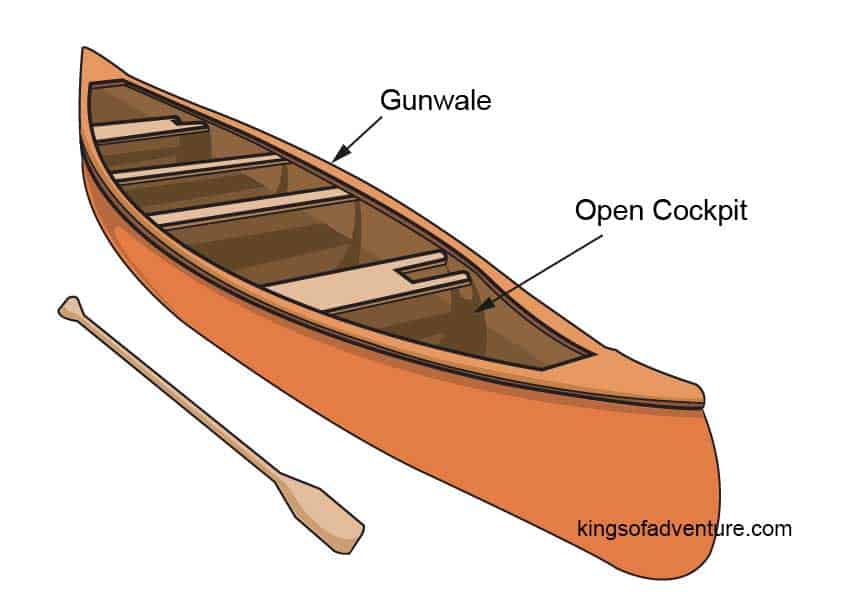
Well, to begin with, canoes have what is commonly referred to as an “open cockpit” (the place where the paddler or paddlers sit) and gunwales (the upper edge of a ship or boat’s side) that are positioned well above the waterline. While kayaks have a “closed cockpit” and gunwales that are positioned a very short distance above the waterline.
Also, as mentioned above, canoes commonly have two bench-like seats that are fixed to the sides of the cockpit so that when a paddler sits in a canoe, their posterior is positioned level with or, just below, the gunwale with their feet resting flat against the bilge as if they were sitting in a chair.
Whereas kayaks commonly have either a molded composite or plastic seat positioned just above the bilge which forces the paddler to extend their legs out in front of them with their feet resting against a pair of adjustable foot pegs, and their knees resting against the underside of the front deck which aids the paddler in maneuvering the craft. Some people invest in a more comfortable kayak seat which offers good back support. This makes longer journeys more comfortable.
Parts of a Canoe – Plan View
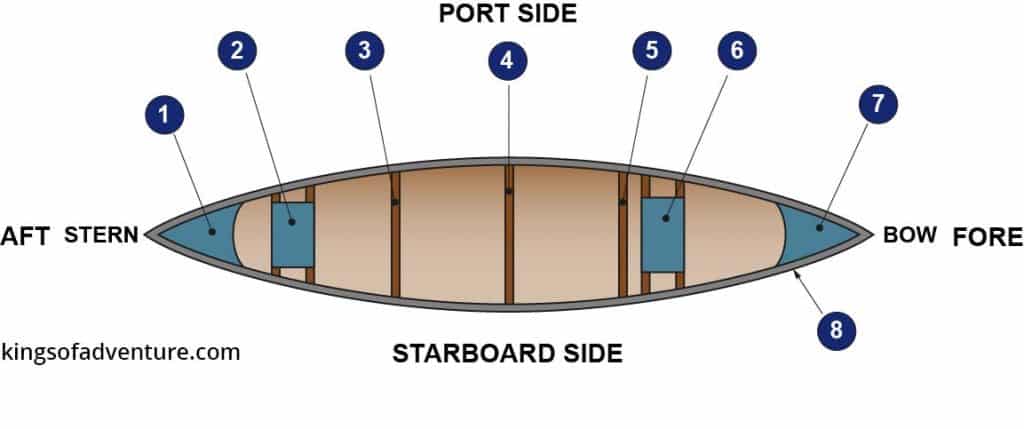
- STERN DECK
- STERN SEAT
- STERN THWART
- MIDSHIP THWART
- BOW THWART
- BOW SEAT
- BOW DECK
- GUNWALE
Parts of a Canoe – Side View

- LENGTH
- STERN
- AMIDSHIPS
- BOW
- WATERLINE
- KEYLINE
- WATERLINE LENGTH
- DRAFT
- FREEBOARD
What is Rocker on a Canoe

- HIGH ROCKER
- MODERATE ROCKER
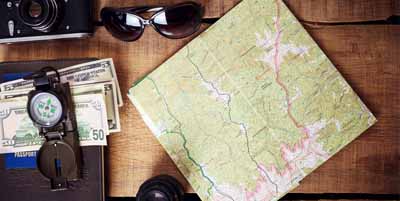
Gift Ideas for Outdoor People
Looking for Christmas or birthday gifts for your adventurous loved ones? Check out our ultimate guide
Types of Canoes
- Recreational canoes
- Square Stern Canoes
- Whitewater canoes
- Racing canoes
Types of Kayaks
- Sit-inside kayaks
- Sit-on-top kayaks
- Inflatable kayaks
Kayak types can be further sub-dived into:
- Recreational kayaks
- Day touring kayaks
- Expedition kayaks
- Whitewater kayaks
- Surf kayaks
- Surf skis
- Racing kayaks
So, at this point, you are probably wondering what the differences are between all of these different types of paddlecraft, so let’s start with canoes.
What are the Differences Between the Types of Canoes?
Recreational Canoes
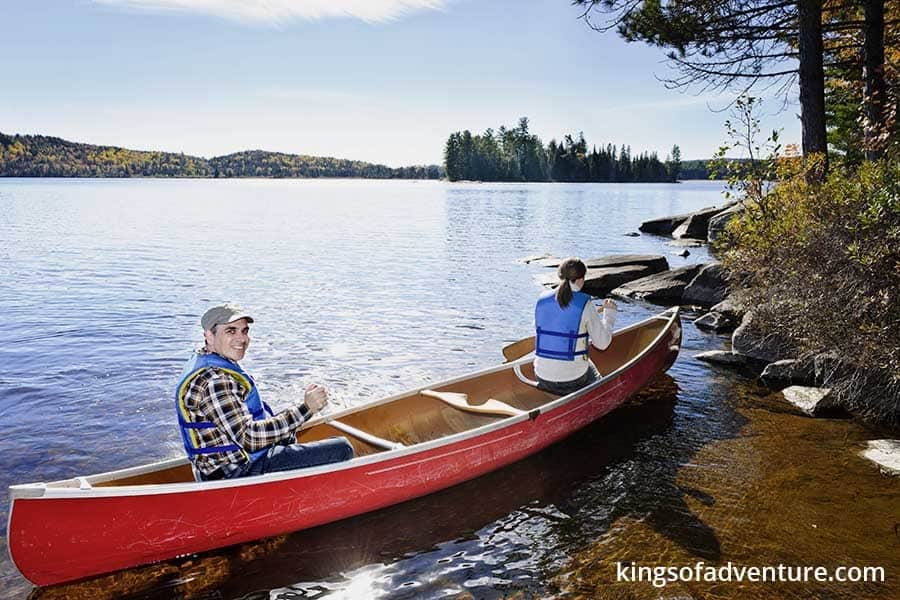
To begin with, recreational canoes are commonly between 13 ft. and 17 ft. long and are designed to have a high degree of initial stability as well as to be easy for the paddler or paddlers to control and because of this are the most common type of canoe chosen for paddling on lakes, ponds and, slow moving rivers. These are equally good canoes for families as they are for one person canoes.
Flat Back Canoes
Square stern canoes are built with a flat rear to accommodate a motor if so desired. These are a good idea if you’re going on an extended trip when the gentle output from a small trolling motor can give you a well-earned rest from paddling.
Whitewater Canoes
Whitewater canoes on the other hand, are often significantly shorter than recreational canoes and have a higher degree of rocker in order to make them more manoeuvrable, but, they are far more difficult to paddle in a straight line. In addition, they generally have a much lower degree of initial stability than recreational canoes in order to enable the paddler to lean them on their chines. They are generally outfitted with air-filled floatation bags to prevent water from filling the cockpit and sinking the craft.
Racing Canoes
Racing canoes differ from both recreational and whitewater canoes in that they are much more narrow in order to present less wetted surface area for increased speed, and they sit lower in the water to help compensate for the lack of initial stability. Plus, they generally lack bench seats and instead, the paddler or paddlers kneel in the bilge, which increases their initial stability.
KAYAKS
Parts of a Kayak – Plan View
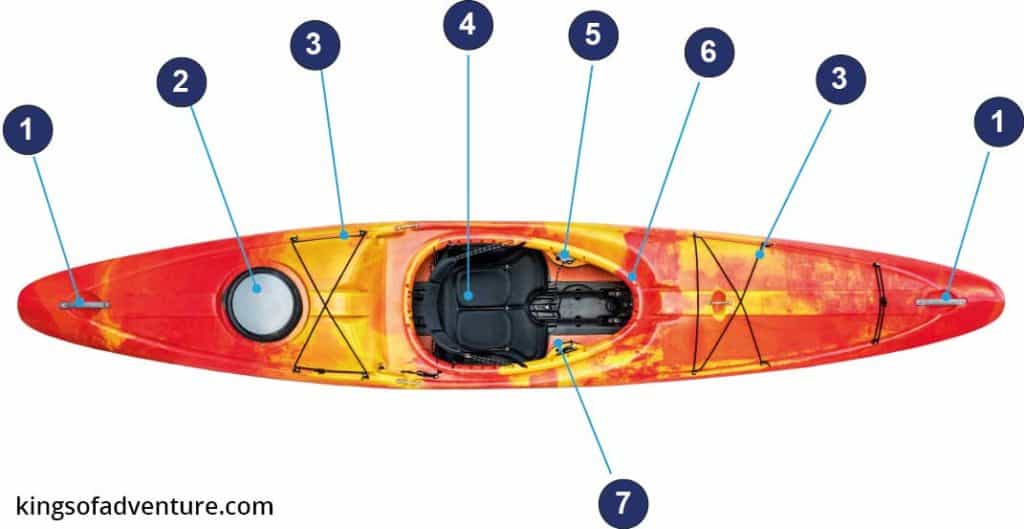
- Carry Handle
- Hatch
- Geck lines
- Seat
- Thigh braces
- Coaming
- Cockpit
Types of Kayaks
As mentioned above, not only are there three different categories of kayaks, there are seven different types that are all designed for specific purposes.
Sit Inside Kayaks
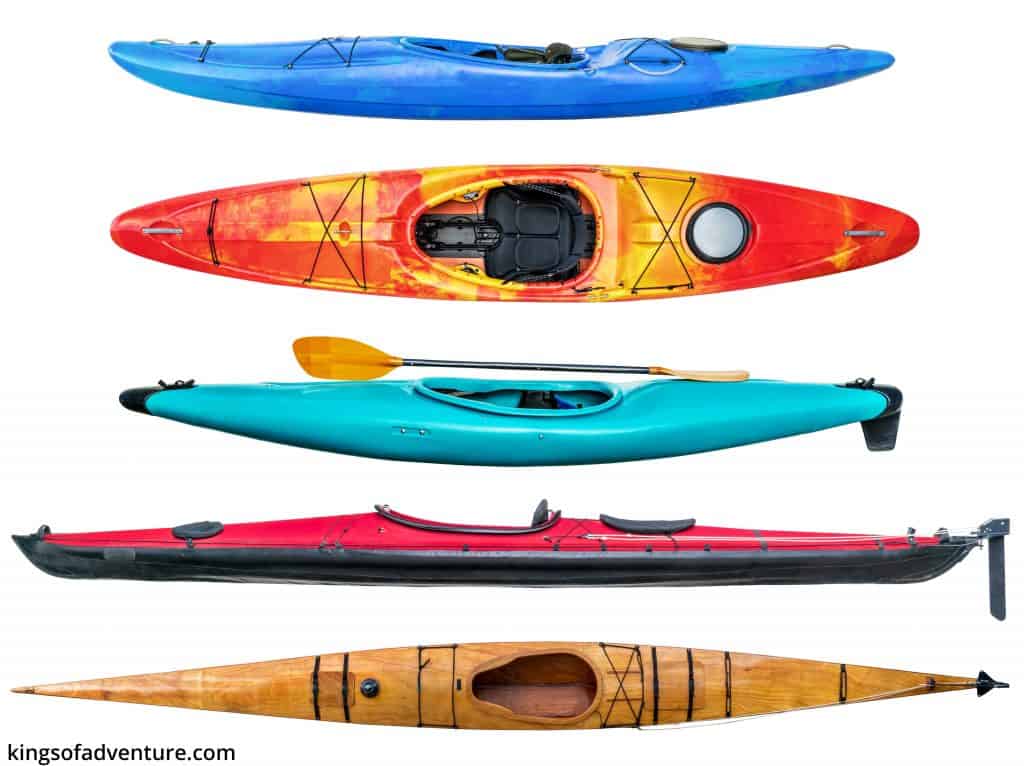
As the name implies, sit-inside kayaks have the classic closed cockpit with a seat that is positioned adjacent to the bilge
Sit On Top Kayaks
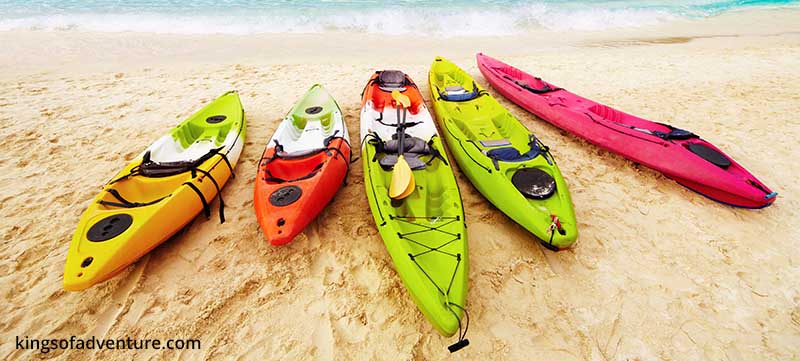
whereas sit-on-top kayaks have open cockpits just like a canoe does and, the same is true of inflatable kayaks (below).
Inflatable Kayaks
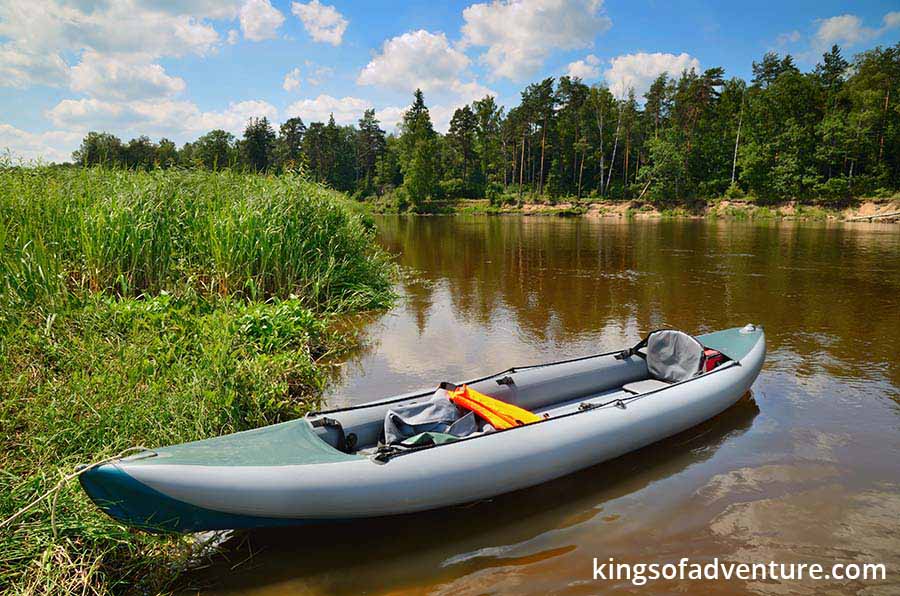
But, this is where kayak classification gets complicated, because while sit-on-top and inflatable kayaks are both classified as recreational kayaks, there are seven different types of sit-inside kayaks consisting of recreational kayaks, whitewater kayaks, surf kayaks, day touring kayaks, expedition kayaks, surf skis and, racing kayaks.
Recreational Kayaks
Recreational kayaks are generally rather wide in order to provide paddlers with a high degree of initial stability and rather short to make them highly maneuverable.
Both sit-on-top and inflatable kayaks are considered to be recreational kayaks.
Whitewater Kayaks
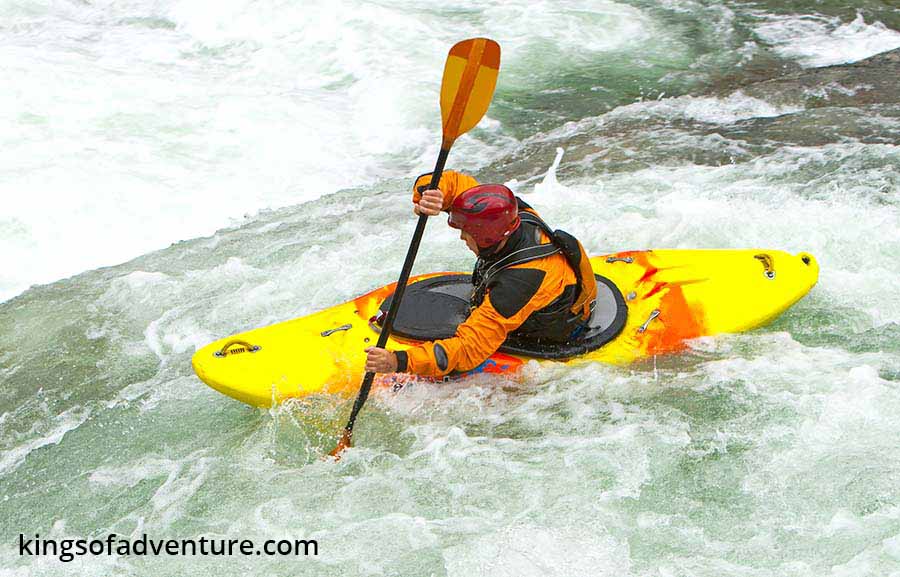
Similar to recreational kayaks, most whitewater kayaks are sit-inside designs that are also rather short, but, their hulls have a much higher degree of rocker in order to make them even more maneuverable.
Surf Kayaks
Next, there are surf kayaks which, at first glance, often appear to be very similar to whitewater kayaks but have hulls that are specifically designed for surfing waves.
Day Touring Kayaks
Day Touring Kayaks on the other hand are often available in both sit-inside and sit-on-top designs and, they are generally significantly longer than whitewater kayaks in order to provide the paddler with more speed for paddling over longer distances. Plus, they have less rocker in order to better enable them to travel in a straight line (called tracking) with less effort. Day touring kayaks are most often chosen for medium-range paddling excursions.
Expedition Kayaks
Next, we have expedition kayaks, and as the name implies, are specifically designed for long-range paddling excursions as well as for kayak camping. All expedition kayaks are sit-inside designs, they are generally longer and wider than day-touring kayaks with more internal volume and sealed bulkheads. This provides both extra dry storage space for camping gear, food, and freshwater, as well as additional floatation.
Racing Kayaks
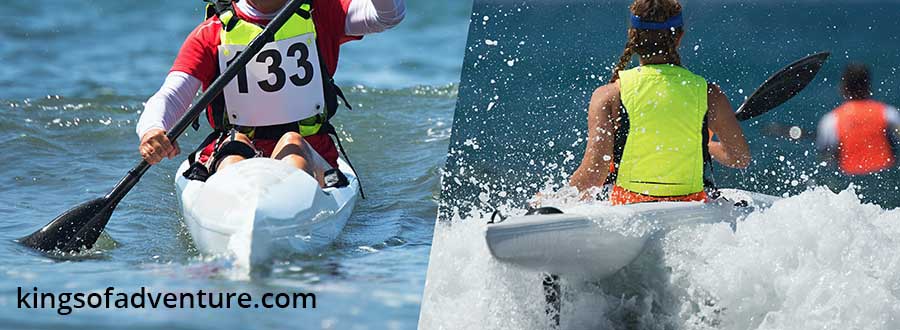
Last but not least, there are two different types of racing kayaks consisting of sit-inside designs which are simply called “racing kayaks” and “surf skis” which are all sit-on-top designs. However, both types are much longer and much narrower than either day touring or expedition kayaks and they have a significantly higher degree of rocker. Both types are much faster than day touring or expedition kayaks but, they are also far less stable. They generally require a rudder to keep them traveling in a straight line despite their length.
So, now that you have a basic understanding of the different types of canoes and kayaks, you might be wondering what the pros and cons of each type of paddle craft are, so we’ve listed these below:
Enjoying this article? You might also like:
Canoeing vs Kayaking
Canoeing and kayaking are quite different experiences from each other.
The most obvious difference is the paddle characteristics and how you use it to move through the water.
The image above shows the differences between a canoe paddle and a kayak paddle. A canoe paddle is single-bladed and the kayak paddle has 2 blades, one at each end of the paddle.
Let’s assume for a moment, that both vessels are single-seater, solo craft.
Canoeing – Paddling and Turning
To paddle a canoe, the paddler would be sat at the rear of the vessel and would insert the paddle into the water on one side for one or two strokes, then insert the paddle into the water on the other side of the vessel for the same number of strokes and weight of the stroke. This balance of stroke enables you to keep the canoe traveling in a straight line.
To turn right you would paddle the canoe on the right-hand side only, and the left-hand side to turn left.
Alternatively, you can steer the canoe by inserting the paddle into the water and angling the blade like a rudder to facilitate the turn. This method can only work when the canoe is already moving.
Kayaking – Paddling and Turning
To paddle a kayak, the paddler would be sat in the middle of the vessel and would insert the paddle into the water on one side for one stroke, then insert the paddle into the water on the other side of the vessel for the same number of strokes and weight of the stroke. This balance of stroke enables you to keep the kayak traveling in a straight line.
To turn right you would paddle the kayak on the right-hand side only, and the left-hand side to turn left.
Alternatively, you can steer the kayak by inserting one end of the paddle into the water and angling the blade like a rudder to facilitate the turn. This method can only work when the kayak is already moving.
Canoe vs kayak pros and cons:
Advantages of a Canoe
- Canoes are generally more stable than kayaks due to their width.
- Canoes are easier to enter and exit than kayaks.
- Canoes have a much higher load capacity than kayaks and so can carry more gear.
- You get a better view of your surroundings in a canoe than you do in a kayak due to the higher seating position.
- Solo portaging (by-passing sections of water via land) regularly is much easier in a canoe than in a kayak because it’s easier to unload and reload your gear.
Disadvantages of a Canoe
- Canoes have open cockpits, which expose the paddler to sun, wind, and spray.
- Canoes have less efficient hull designs than kayaks and so require more effort to paddle.
- Canoes are less maneuverable than kayaks and so require more effort to turn.
- Canoes often weigh more than kayaks and therefore require more effort to transport.
Advantages of a Kayak
- Kayaks have more efficient hull designs than canoes and so require less effort to paddle.
- Kayaks are more maneuverable than canoes and so require less effort to turn.
- Most kayaks are lighter than most canoes, which makes them easier to transport.
- Sit-inside kayaks have closed cockpits, which protect the paddler from sun, wind, and spray.
- Sit-inside kayaks have dry storage holds.
- Sit-inside kayaks can be rolled upright after a capsize.
Disadvantages of a Kayak
Kayaks are less stable than canoes, which makes them more prone to capsize.
Kayaks are more difficult to enter and exit than canoes.
Kayaks have a much lower load capacity than canoes, they cannot carry as much gear.
Canoes vs Kayaks: Which to Choose?
So, as you can see, not only are there several types of canoes and kayaks designed for different purposes, they each have many different pros and cons.
So, which type of paddle craft is best for you?
Well, the answer to that question really depends on your personal preferences. If you are new to the sport of paddling and are still undecided on which type of paddle craft to choose, read on as there are a few things that you should keep in mind such as:
How important is speed to you?
If you are one of those people who prefer to glide across the water with a minimum of effort while covering long distances during the course of the day, then a kayak is a better choice.
How important is stability to you?
If you are one of those paddlers who is intimidated by the idea of capsizing, then a canoe is a better choice.
How important is maneuverability to you?
If you plan on exploring convoluted coastlines and/or entering creeks, or paddling in swamps, marshes or bayous, then a kayak is a better choice.
How important is load capacity to you?
If you are one of those paddlers who doesn’t mind traveling at a slower pace as long as you have plenty of room for all of your camping gear and/or a fellow paddler or a paddling companion, then a canoe is a better choice.
What type of water will you be paddling on most often?
If you plan on paddling on calm water most often, then a canoe can be a better choice for you. But, if you plan on paddling on large lakes, or bays where the wind can cause the water to become rough or if you plan on paddling in the surf, then a kayak is a better choice.
Will you be frequently entering and exiting your paddle craft?
If you are one of those paddlers who plan on entering and exiting their paddle craft frequently during the day to explore land features, or to portage from one body of water to another, then a canoe is a better choice.
So, as mentioned above, the choice between a canoe and a kayak really comes down to personal choice since they both have advantages and disadvantages that cause paddlers to choose one type of paddle craft over the other.
It is important to carefully consider what type of water you will be paddling on most often as well as to contemplate your answers to the questions listed above so that you can choose the type of paddle craft that best suits your intended purpose.
Regardless of which type of paddle craft you choose, paddling is a great way to get outdoors and have fun on the water during the warmer months of the year as well as to explore local bodies of water.
If you are interested in canoeing or kayaking, but not sure which one to choose, here are some tips on how to find the right boat for you:
Consider your goals
What do you want to do with your boat? Do you want to paddle for fun, fitness, adventure, or something else? Do you want to go solo or with others? Do you want to stay close to shore or explore far away places? Do you want to paddle on calm or rough water?
These questions will help you narrow down your options and find the boat that matches your goals.

